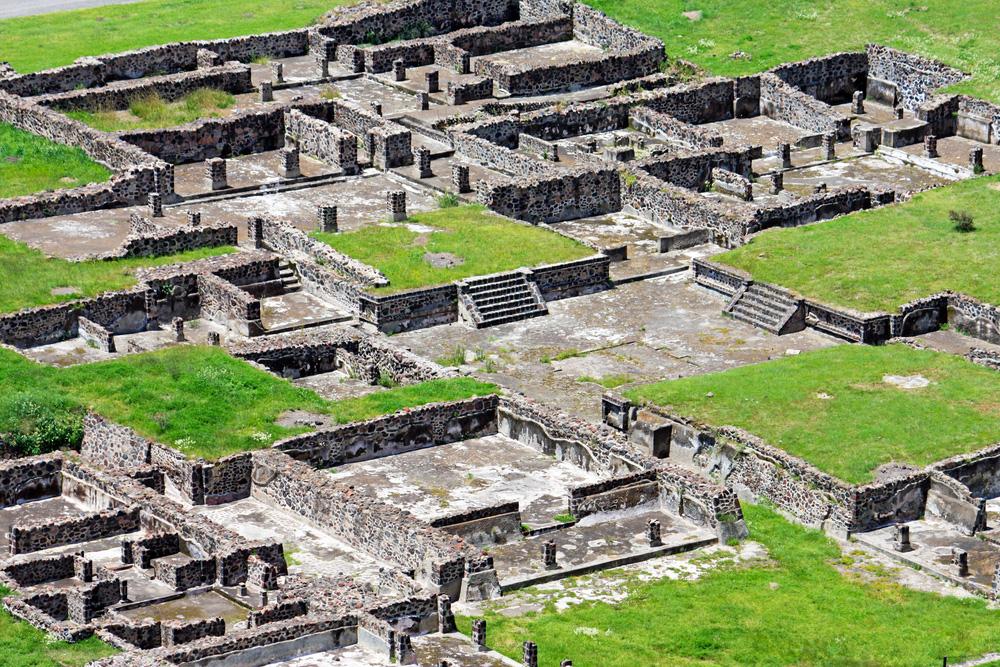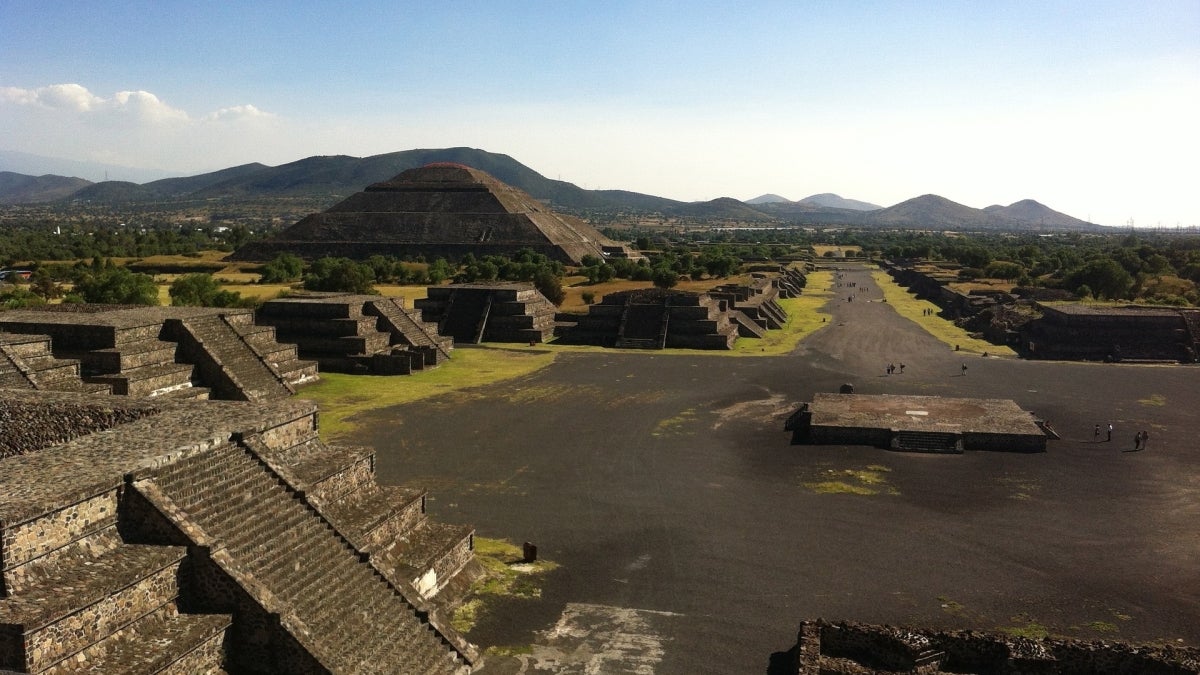Have you ever felt a deep, instant bond with a city? A place where the people, culture and even the architecture all seem to whisper, “This is where you belong”?
Arizona State University’s Michael Smith experienced this feeling as a student in the '70s — but for a city that had sat unoccupied for more than 1,000 years.
“Teotihuacan was my ‘first love’ in archaeology,” he said.
So he threw himself into a world of artifacts and ruins to piece together what life was like in Teotihuacan’s heyday. While it’s known the city hosted a peak population of 80,000 and influenced culture in the surrounding area during — and even after — its time, just who built and ran the place is something of a mystery. Along the way to uncovering those secrets, however, Smith is finding valuable lessons for our own modern cities.
In the last year, he has studied everything from inequality in the world’s ancient settlements to buying and selling in the Aztec empire. But for the Teotihuacan Research Laboratory director and School of Human Evolution and Social Change professor, the journey to get there didn’t start with amazing discoveries.
It started with a wide-eyed undergraduate who connected with an ancient city.
A legend sparks a lifelong passion
After reading a book during college that suggested ancient Mesoamericans were from the lost city of Atlantis, Smith read up on the Aztecs and Maya. Though he quickly dismissed the story as “a bunch of baloney,” the lure of a civilization with unknown mysteries stuck with him. Through archaeology, he realized, the sealed doors of time could indeed be cracked open.
He took courses from Professor George Cowgill, a world authority on Teotihuacan, and lost himself to the ancient city after a summer research project there.

Michael Smith at Teotihuacan as a student in 1974.
“I found the experience of walking the fields, finding traces of ancient sites and visiting major ruins very exciting, something I wanted to devote my career to,” Smith said. “I also fell in love with Mexico — the country, the people, the food, the music.”
After earning his graduate degree, Smith spent nearly 15 years doing fieldwork on Aztec daily life in Cuernavaca, Mexico, before returning to Teotihuacan to support the site’s research laboratory and eventually replace Cowgill when he retired as lab director.
“Switching my research from the Aztec period back to Teotihuacan was a natural development,” he said, despite the thousand-year difference between the two societies.
His research had undergone another change — one activated when the ASU Department of Anthropology broke down the barriers between anthropology’s subdisciplines and added new areas of study around applied math, health and the environment, becoming the School of Human Evolution and Social Change.
Though he was skeptical at first, Smith now describes this as a “turning point” for himself and the school, as it prompted him to work with researchers from other fields and study cities through the ages. This gradually became his main research focus, and his work at Teotihuacan only reinforced it.
“During this process, I was transformed from an archaeologist with comparative interests into a truly transdisciplinary scholar of urbanism,” Smith said. Today, he admits he’s as likely to read a sociological paper on neighborhoods as he is an archaeological account of the Aztecs.
At Teotihuacan, the expanded possibilities of interdisciplinary work bring revelations that manage to surprise even one of the men who know it best.
Shocking levels of equality in an ancient society
Despite our progress in many areas since the time of Teotihuacan, modern cities still grapple with increasing gaps between the rich and poor. Some of the solutions for the future, however, may lie in the past.
Smith’s recent work, published with Timothy Kohler of Washington State University in Nature, explored the roots of inequality, starting with ancient settlements around the world. Working with a team of researchers from other institutions, Kohler and Smith found that once people made the switch to farming, inequality kept climbing in the Old World, yet stayed the same in the New World.
The culprits, according to their study, were draft animals. Horses, cows and the like allowed the wealthy Old World farmers who owned them to plow more land and grow extra food, making them even richer. In the New World, meanwhile, draft animals weren’t available, so farming was limited by the use of human labor.
He and the team used the differences in house size at various settlements to calculate their Gini indexes — a standard measurement of inequality where zero means everyone has the same amount of wealth and one means a single person holds all the wealth.

Palace of the Sun, a housing compound at Teotihuacan.
Naturally, one of the settlements measured for the study was Teotihuacan. Though it was one of the largest ancient cities in the New World, its index is a surprisingly low 0.12.
“In fact, this is the lowest Gini index for any state-level society ever studied,” Smith said. He explained that the widespread use of large homes and the absence of a big royal palace give Teotihuacan its low score.
This society stands in contrast to that of the Aztecs, whose economy Smith researched for his new book, "Rethinking the Aztec Economy."
The Aztecs were a people of strict social classes, which shows in the way they viewed wealth and ownership.
They used currency (cacao beans for small purchases, set sizes of cotton cloth for large purchases) to measure and track wealth. Some members of the middle class, like merchants, could occasionally become richer than nobility — but they had to hide it. Commoners were also barred from land ownership, which was only for the nobles who ruled the government.
At Teotihuacan, meanwhile, signs of high wealth-equality abound. Luxurious apartment compounds with colorful mural paintings on the walls and open-air patios were the standard for the average home.
Smith and Kohler will explore the topic and its takeaways for modern cities even further in their upcoming book, "Ten Thousand Years of Inequality: The Archaeology of Wealth Differences."
“One basic lesson is that it is possible to have a large and prosperous city without having a huge underclass of poor, disenfranchised people,” Smith said. “If the ancient people of Teotihuacan could figure out how to do this, then perhaps today’s cities can, too.”
Where the mysteries are hidden in plain sight
After being inducted as a fellow of the American Association for the Advancement of Science next month, Smith plans to immerse himself in research at Teotihuacan — but amazingly, none of it involves him picking up a shovel.
That’s because decades of archaeologists have done the digging for him. In fact, the lab facility at Teotihuacan is stuffed to the brim with artifacts and records, and many of them have never even been studied. ASU students often travel to the lab and spend their summers trying to help catalog it all.

Smith working in the Teotihuacan lab.
“Much can be learned about ancient Teotihuacan without carrying out new fieldwork,” Smith said. “Like all archaeologists, I love fieldwork, and the thought of digging at Teotihuacan is tantalizing. But I realized that I can create more and better knowledge of the site — more ‘bang for the buck’ — by concentrating on the existing data.”
One project based on this concept is the completion of the Teotihuacan Mapping Project, an effort to map the entire ancient city that began in the 1960s. Smith recently received a National Science Foundation grant to finish many of the outstanding tasks and archive the data and results in ASU’s the Digital Archaeological Record, an online archive of archaeological data managed by the Center for Digital Antiquity.
Another major focus will be analyzing Teotihuacan’s unusual form of standard housing, called the apartment compound, to begin uncovering the mystery of why everyone lived in luxury villas. Smith believes that understanding this aspect of Teotihuacan life will open a window into even more areas of their society, from economics to their ever-elusive form of government.
It’s easy to see why, nearly 40 years later, Smith continues to have such a passion for this ancient city. With each new generation of researchers come fresh insights into its past — of the archaeological, rather than the Atlantian, variety.
Now a respected authority in his own right, Smith is able to instill that same passion in even more wide-eyed students, setting them on a path to unknown discoveries and ensuring that Teotihuacan lives on as a scientific and cultural model for thriving future cities.
More Arts, humanities and education

ASU workshop trains educators, professionals from marginalized communities in disaster science
As devastating as hurricanes can be to anyone caught in their paths, they strike marginalized communities even harder.To address this issue, a fund named for a former Arizona State University…

ASU’s Humanities Institute announces 2024 book award winner
Arizona State University’s Humanities Institute (HI) has announced “The Long Land War: The Global Struggle for Occupancy Rights” (Yale University Press, 2022) by Jo Guldi as the 2024…

Retired admiral who spent decades in public service pursuing a degree in social work at ASU
Editor’s note: This story is part of coverage of ASU’s annual Salute to Service.Cari Thomas wore the uniform of the U.S. Coast Guard for 36 years, protecting and saving lives, serving on ships and…
